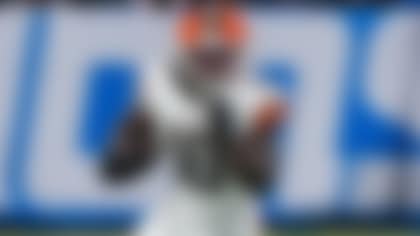Who are the greatest traded players of all time? That was the question posed to me by my editor after the trades that sent Antonio Brown to the Raiders and Odell Beckham Jr. to the Browns. It's rare to have star players shopped in their primes, even with the economics of the sport playing an ever increasing role.
To determine who the top traded players are, shouldn't what they did afterward count? If a guy can only produce with one franchise, or only in that one team's scheme, is he really an elite player? If you only count how prolific a player is before he was traded, then what about all those who were incredible after they were dealt? In other words, just like there were so many premier players who failed to produce in new locales, like Herschel Walker, there were those, like Steve Young, who accomplished little before being traded elsewhere.
The below names, presented in reverse order, are the greatest traded players in NFL history:
20) Khalil Mack, pass rusher
Mack, at least at the time of his trade to Chicago, was as dominant a performer as any player on this list. It's difficult to gauge Mack's legacy, with such limited service in the league and only one season in his new locale under his belt. Yet, you can make the argument that perhaps no player has ever been traded while playing at the level Mack has these last few seasons. When he was healthy in 2018, no defensive player was better, as his 12.5 sacks and 18 QB hits were huge reasons the Bears had one of the most feared defenses in the league, and he helped foster great team success. After another year like that, people are going to talk about Mack as a future Hall of Famer.
19) Fred Dean, pass rusher
If there is an underrated player in the Hall of Fame, you might start with Dean. Like Mack, Dean was an All-Pro level pass rusher at the time of his trade to the 49ers in 1981. The difference between the two is the difference Dean made in his first season in San Francisco. You think Mack turned around the Bears? Dean's 12 sacks in 11 games helped Bill Walsh's 49ers go from 6-10 to 13-3 and hoisting a Lombardi Trophy in one year! Two years later, Dean had 17.5 sacks. He was a streaky player, but the instant ROI on this deal elevates his legacy.
18) Tony Gonzalez, tight end
Gonzalez would rank higher on this list if he had been traded closer to his prime. In fact, none of the other players detailed below spent 12 years with one team before being traded, like Gonzalez did in Kansas City. Gonzalez established a reputation as the best tight end in football, perhaps in history, when he was shipped to the Falcons. Gonzalez didn't merely just walk to the finish line of his career in Atlanta. Rather, he played at a very high level, helping the Falcons make it to the NFC Championship Game in 2012, while also being named first-team All-Pro for the sixth time. Gonzalez caught over 400 passes in five years in Atlanta, which is more than a lot of very good tight ends catch in their entire careers.
17) Nick Buoniconti, linebacker
Buoniconti was already a ferocious linebacker with the Boston Patriots of the AFL when the Dolphins acquired him. What a gift for Don Shula, who arrived to take over the head coaching job in Miami the following year: The leader of his defense, a first-team All-Pro in '69, was already in place. Buoniconti would man the middle and make the calls for perhaps the most underrated defense of all time. The "No Name" defense, as they came to be known, allowed the fewest points in the NFL in 1972 and '73. Buoniconti made six AFL All-Star games, then, after the merger, was selected to two more Pro Bowls. But it's his leadership that he is most remembered for.
16) Jerome Bettis, running back
The Bus was traded in his prime, even if the numbers totally didn't reflect that, after the wheels had already gone round and round a few times. Bettis bulldozed the league as a rookie in 1993 with over 1,400 yards rushing, then added another 1,000 yards to his tally in 1994. However, in 1995, the Rams got a new head coach, Rich Brooks, who wanted to throw the ball around the yard, not focus on the ground game like his predecessor, Chuck Knox. That meant Bettis was on the market. The Rams traded him to the Steelers with a third-round pick for a second-round pick in the '96 draft and a and fourth-rounder in '97, and all Bettis did was lead the AFC in rushing his first year in Pittsburgh. In the end, he piled up over 10,000 yards in a decade with the storied franchise. Bettis became a premium goal-line and short-yardage DH his final year with the Steelers, capping off his career with a win in Super Bowl XL.
15) Paul Krause, safety
Krause retired as the NFL's all-time leading interceptor with 81 in 1979. Before he was traded to the Vikings and started four Super Bowls for Bud Grant's Minnesota teams, he was a standout safety for the Redskins. Krause led the league in interceptions as a rookie with 12, and over four seasons in Washington, he totaled 28, which would be a career figure for some folks. In the days when the free safety's job was often to play a roaming center field, Krause was the most dangerously effective. He didn't mind taking a chance on jumping a route, consistently providing the Vikings offense with a short field. Krause helped Minnesota improve from a three-win team to eight wins during his first season there. Partially due to his ballhawking skills, the Vikings allowed the fewest points in the league every year from 1969 to 1971. Krause's career interceptions total will never be matched.
14) Y.A. Tittle, quarterback
Tittle didn't quite deliver the championship goods in San Francisco or New York, but he came awfully close. Tittle was named first-team All-Pro in 1957, and he was one of the finest passers in the NFL of the 1950s. In 1961, head coach Red Hickey wanted to continue with a new shotgun offense, which often saw his quarterbacks running out of that formation. That was no system for a QB entering his 14th season. Thus, Tittle was shipped off to the Giants, where he lit up the league for the next three years. Tittle led New York to the championship game three years in a row, from 1961 to '63, and he was also named NFL MVP by at least one national media outlet in each of those years. He tossed 69 touchdown passes over the '62 and '63 seasons alone. The only thing keeping Tittle from being higher on this list is the lull in his play his last three seasons in San Francisco. He no doubt elevated his play upon leaving.
13) Norm Van Brocklin, quarterback
Van Brocklin toiled for the Rams for nine years, winning a championship in Los Angles over the Browns and losing a title game to them. Despite playing well for most of the 1957 season, inconsistency and strained relations with head coach Sid Gillman led Rams general manager Pete Rozelle to trade "The Dutchman." Two years later, Van Brocklin enjoyed his finest season, leading Philadelphia to a win in the 1960 Championship Game. He was named league MVP after the season, then retired. How about that?
12) Sonny Jurgensen, quarterback
When Jurgensen was swapped for Norm Snead, it seemed no one knew what to make of Washington's new QB. Why would the Eagles trade a player in the middle of his prime? Presumably, part of the problem was Philly's paltry win total (three) in 1963. Jurgensen missed significant time that year, and when he did start, well, his record was 1-6-1. The Redskins didn't win much in Jurgensen's first five years with the team, either, but the future Hall of Famer played like a champion. Interceptions had been an issue for him in Philly, but he never threw more than 20 in Washington. After making three Pro Bowls and becoming one of the most effective passers in the NFL, Jurgensen soared in his one year with Vince Lombardi, going 7-5-2 in '69 and pacing the league in passing yards while being named first-team All-Pro. Jurgensen helped Washington to the Super Bowl in 1972, and two years later, he won three out of four as a 40-year-old.
11) Randy Moss, receiver
Moss was an all-timer masquerading as an average wideout when the Patriots traded for him. After two subpar seasons in Oakland, New England got him on the cheap, dealing the Raiders a fourth-round pick for a guy who would catch nearly 50 touchdown passes over the next three seasons. Bill Belichick was getting a disgruntled player, tired of the losing culture experienced over two injury-plagued seasons with the Raiders, who could still dominate. Moss' attitude was not a problem early on with the Patriots, as he proved he was still the top player at his position in the NFL by posting a record 23 touchdown catches in '07. Oakland can only hope Antonio Brown will do the same for the Raiders this year.
10) Fran Tarkenton, quarterback
The second deal listed above is the one worth focusing on. Big Blue never really recovered from the retirement of Y.A. Tittle following the 1964 campaign -- even acquiring the ever-scrappy Tarkenton, who competed his butt off for the Giants, couldn't fix that. Whereas by the early '70s, the Vikes had drafted great talent on the defensive side of the ball, including 1971 MVP Alan Page (a defensive tackle). All they needed was a solid QB. Tarkenton gave them a Hall of Fame-caliber signal-caller, taking Minnesota to the Super Bowl three times while winning an MVP himself in 1975.
9) Willie Brown, cornerback
Brown was an outstanding, if unknown, DB before he was dealt to the Raiders. What a masterstroke by Raiders owner Al Davis, who added one of the elite cover corners in NFL history, a player who would excel in Oakland for 11 seasons. Most people have seen the "Old Man Willie" clip from Super Bowl XI. What they might not know is that play was well beyond Brown's prime, when he was as good as they come. Consider that in his first year with the Raiders, the defense allowed four fewer points per game than it did in the previous season. Along with Daryl Lamonica (added via another great trade), Brown helped Oakland improve its win total by five and make it to the Super Bowl in '67. In fact, the Raiders only missed the postseason twice and never had a losing season during Brown's tenure. He went from being an AFL All-Star to a multiple-time first-team All-Pro in his new city, winning a Super Bowl in his old age.
8) Champ Bailey, cornerback
It's not often a team trades one star for another, but the Redskins' decision to send Champ Bailey to the Broncos for Clinton Portis paid off. Both players excelled with their new franchises, and both teams made the playoffs with their new players. It was Bailey, however, who raised his game a notch, evolving from a Pro Bowl-caliber player to the top corner in football in the mid-2000s. His 2005 and '06 seasons would be difficult to top: He posted 18 interceptions, including three returned for touchdowns. Six of his picks in 2006 were in the red zone. Think about how many points that saved. Bailey was in the middle of his prime when he was traded away by Washington, and yet he still managed to play 10 more seasons. His brilliant career will be recognized when he is enshrined in Canton this summer.
7) Ken Houston, safety
Traded from: Houston Oilers to Redskins, 1973.
Houston was traded at the height of his career, having scored 10 defensive touchdowns in six years with the Oilers, including nine on interception returns. The problem: Houston -- as in, the team -- couldn't score many points without their safety's help. But they sure could give them up. The Oilers won all of one game in '72, prompting them to deal Houston to the Redskins for five veteran players. The trade worked out -- for Washington. Houston made the Pro Bowl in the next seven seasons, continuing an incredible run of 12 straight Pro Bowls, while the Redskins posted a winning record in six of his eight years with the team.
6) Marshawn Lynch, running back
Lynch ran hard in Buffalo, rushing for over 1,000 yards in each of his first two seasons with a team that had virtually no passing game to speak of. Off-the-field problems derailed Lynch's 2009 campaign, and with the Bills starting 2010 0-4, he was deemed expendable. Lynch's "Beast Quake" touchdown rumble versus the Saints will live forever in pro football history, and it showed just how great this player was in a different uniform away from a losing culture. No player in league history ever played better after a trade. Lynch would go on to be the focal point of a Seahawks team that won it all in 2013 and probably would have won it again the next year if Beast Mode had gotten one more carry. Lynch rushed for over 1,000 yards his first four full seasons in Seattle, scoring 56 rushing and receiving TDs in the process. He was the heart and soul of one of the greatest teams of the 2010s.
5) Charles Haley, defensive end
If the point of acquiring a player in his prime is to win championships, then Haley should be the poster child for every blockbuster deal. In need of a proven pass rusher to bolster a promising D, the Cowboys traded for Haley, who had produced four double-digit sack seasons in San Francisco. Mission accomplished. The consistent pressure provided by Haley allowed the D-line to succeed as a group and the young secondary to flourish, and Dallas owned the No. 1 defense in the league in 1992. The Cowboys would go on to win the Super Bowl that year, then repeat in 1993. Haley dominated in 1994, posting 12.5 sacks and being named first-team All-Pro as Dallas finished with the top defense in the league again, narrowly missing on a three-peat in the process. In 1995, he tacked on 10.5 sacks and helped Dallas win yet another Super Bowl. Three Lombardi Trophies in four years, acquired for a second- and third-round pick. Not bad.
4) Mike Haynes, cornerback
Haynes was already a top-flight corner when the Patriots shipped him to Los Angeles. Haynes was unhappy with his contract in New England, feeling that he deserved to be the highest-paid corner in the league, and had been holding out. A deal between to the two organizations was made shortly after the trading deadline; after moving through the courts, a settlement was reached that gave New England a first-round pick in 1984 and a second-round pick in 1985. Boy, was Haynes worth it. Joining the Raiders mid-season, he helped them reach Super Bowl XVIII, where he and fellow corner Lester Hayes controlled the flow of the Redskins' pass offense, limiting one of the greatest offenses in NFL history to nine points. Haynes used his length and considerable football instincts to make first-team All-Pro in each of the next two years, and he played seven seasons in his new home at a high level.
3) Ted Hendricks, linebacker
An ill-fated attempt to play in the WFL led to Hendricks' trade to the Packers and then his becoming a free agent, whereupon Green Bay dealt his rights to the Raiders for two first-round picks. At the time, there was little doubt he was the most disruptive outside linebacker in pro football, coming off a season in which he picked off five passes and was named first-team All-Pro. In those days, outside linebackers were not "sack" guys. They played in 4-3 defenses, made tackles, interceded in the passing lanes and occasionally blitzed. Hendricks could do it all exceptionally well -- oh, and he became the best kick blocker the NFL has ever known. The Raiders were getting a complete player. A difference maker. Over nine seasons, the heady play and high football IQ of the 6-foot-7 Hendricks sent him to four more Pro Bowls and pushed the Raiders to three Super Bowl titles.
2) Marshall Faulk, running back
You can't go wrong with either Faulk or the player above him for No. 1 on this list. In 1998, Faulk nearly topped 1,000 yards in both receiving and rushing yards. In 1999, he was the top all-around offensive player in football with the Rams. He led the NFL in yards from scrimmage in both years, then won league MVP in 2000. Faulk was the centerpiece of the "Greatest Show on Turf" Rams, who went to two Super Bowls. Injuries and age caught up to Faulk after that, yet he still remained productive and helped St. Louis reach the postseason in 2003 and 2004. Indy GM Bill Polian, who was worried about how Faulk's dissatisfaction with his contract would affect a young nucleus led by Peyton Manning, only received second- and fifth-round picks for his gifted tailback. The reason he hasn't taken criticism for the move over the years is because the Colts drafted Edgerrin James in 1999.
1) Paul Warfield, receiver
Warfield was coming off consecutive Pro Bowl seasons when he was dealt to the Dolphins, as scary as any receiver in pro football. New Miami head coach Don Shula needed to add a vertical element to what would become the most feared rushing attack in NFL history, and Warfield fit the bill, averaging 25.1 yards per catch to balance an offense, and team, on the rise. The next season, Warfield averaged over 20 yards per catch, led the NFL in receiving TDs with 11 and was named first-team All-Pro. He was a machine in the playoffs, roasting the Chiefs' and Colts' secondaries. The Dolphins would lose in the Super Bowl that year, but Miami didn't lose a single game in '72, thanks partially to the near perfect hands (and feet) of Warfield. He made the Pro Bowl again and averaged over 20 yards per catch for the seventh consecutive season. His premier play never wavered, and he entered the Hall of Fame in his first year of eligibility.












